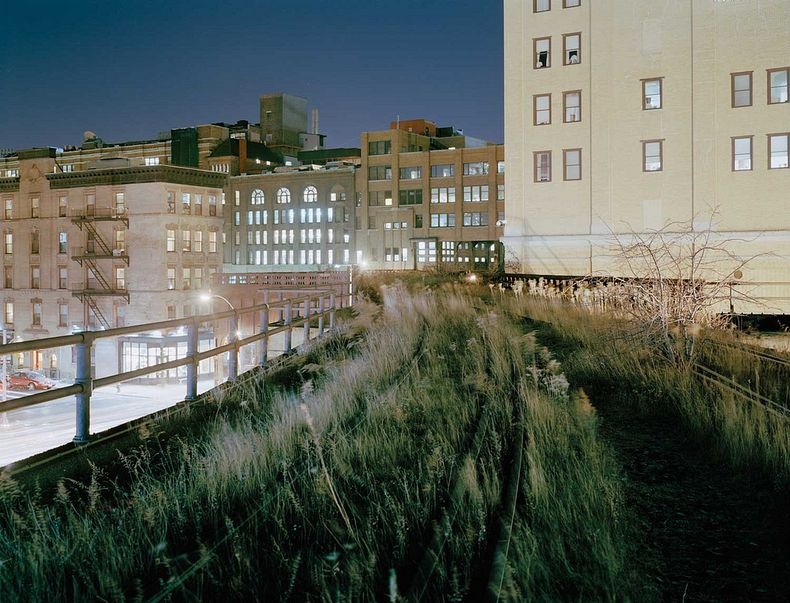The High Line is a mile long, garden park in New York City built on an elevated 1.45-mile section of an abandoned railway line called the West Side Line, which runs along the lower west side of Manhattan. In 1980 the last freight train ran along the elevated railway line reportedly pulling three boxcars of frozen turkeys. Almost twenty years later, in August 1999, local architectural enthusiasts Joshua David and Robert Hammond went along to a public meeting to discuss the future of the High Line. Within months the two New Yorkers, who were regarded as total amateurs and neighbourhood nobodies, founded the Friends of the High Line, a charity that has gone on to transform the abandoned railway line into a wildly successful new oasis for pedestrians.
Since opening in 2009, the High Line has become New York City's second most visited cultural venue, attracting some four million visitors a year. It has been so popular that other cities are following suit, with plans to replicate the formula in London, Chicago, Philadelphia and Rotterdam, Netherlands.
The High Line first opened to trains in 1934. It connected directly to factories and warehouses, allowing trains to roll right inside buildings. Milk, meat, produce, and raw and manufactured goods could be transported and unloaded without disturbing traffic on the streets. With the growth of interstate trucking in the 1950s, rail traffic dropped throughout the nation eventually leading to the disuse of the track. By late 1990s it was overgrown with wild grasses, shrubs, and rugged trees – an ugly relic in an urban city. Finally, New York Mayor Rudy Giuliani ordered the track to be demolished.
Almost a decade after the Giuliani administration tried to tear the High Line down, it has been turned into one of the most innovative and inviting public spaces in New York City. The black steel columns that once supported abandoned train tracks now hold up an elevated park 25 feet above the ground. The park's attractions include naturalized plantings that are inspired by the self-seeded landscape that grew on the disused tracks and new, often unexpected views of the city and the Hudson River. Pebble-dash concrete walkways unify the trail, which swells and constricts, swinging from side to side, and divides into concrete tines that meld the hardscape with the planting embedded in railroad gravel mulch. Stretches of track and ties recall the High Line's former use. Portions of track are adaptively re-used for rolling lounges positioned for river views. Most of the planting, which includes 210 species, is of rugged meadow plants, including clump-forming grasses, liatris and coneflowers, with scattered stands of sumac and smokebush, but not limited to American natives. At the Gansevoort end, a grove of mixed species of birch already provides some dappled shade by late afternoon.
The park extends from Gansevoort Street north to 30th Street where the elevated tracks turn west around the Hudson Yards development project to the Javits Convention Center on 34th Street. It remains open every day from 7 am to 10 pm.


Sources: Wikipedia, BBC, National Geographic Photos: Highline.org




























Google Street View begins right here:
ReplyDeletehttps://maps.google.com/maps?hl=en&ll=40.752618,-74.002043&spn=0.000271,0.000431&t=h&z=21&layer=c&cbll=40.752618,-74.002171&panoid=0945C5JyRsuP4pjlAA3xNQ&cbp=12,157.55,,0,10.06
FYI, one of the early concept of transforming an old railway track to a garden was done in Paris during the 90's. The track was useless because it was replace by a new underground train system (RER trains) and because the Bastille station was removed and replaced by Opera Bastille. Some times after, the high line has been changed to a very nice long park line.
ReplyDeleteYou can see some pictures on a site from the 90's itself on http://www.promenade-plantee.org/
You can see it on Google & Maps with "Coulée verte, Paris, France".
Here is an old documentary done at the end of the station in the 60s by the SNCF (the National Railway Company), jump at 7:00 if you want to see the old high line with a train on it.
http://www.dailymotion.com/video/xc6lop_sncf-archives-la-gare-de-la-bastill_tech
I lIVE in Christchurch New Zealand. and I think THIS would be a GREAT idea for part of our citys rebuild. using steel and bricks, wooden slats n materials fallen from the past earthquakes.. somewere to just mingle ,mix and be.. WONDERFUL THINGS CAN HAPPEN IN THE WORST SITUATIONS...this is great..!!!
ReplyDeleteYou guys need more parks in Christchurch?!? LOL I spent a week there for the millennium transition and there was a park in front of the hotel, a long park from there to downtown with a stream and gondolas on it, and at its end started a huge park with giant trees and a lake! I've been everywhere and I must admit, Christchurch is one of the prettiest cities in the world! So don't ask for more Parks, lucky bastard! :)
ReplyDeleteBest urban renewal project around. I hope this idea spreads to other municipalities.
ReplyDelete